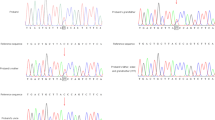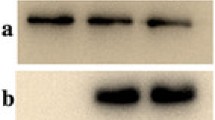Abstract
Hypodysfibrinogenemia is the least frequently reported congenital fibrinogen disorder, characterized by both quantity and quality defects of fibrinogen. In this study, we investigated the molecular basis of hypodysfibrinogenemia in a Chinese family. Functional fibrinogen was measured by Clauss method, and the antigenic fibrinogen was measured by immunoturbidimetry assay. All the exons and exon–intron boundaries of fibrinogen genes (FGA, FGB and FGG) were analysed by direct DNA sequencing. To further evaluate its molecular and functional characterizations, fibrinogen was purified from the plasma of propositus, then SDS-PAGE, fibrin polymerization, clot lysis, and electron microscopy scanning were all performed. The propositus showed a slight decrease of immunologic fibrinogen (1.52 g/L) but dramatically reduced functional fibrinogen (0.3 g/L). DNA sequencing revealed a novel heterozygous CCTTTGATG deletion in the exon 8 of FGG, leading to the deletion of Ala289, Phe290, and Asp291 in fibrinogen γ-chain. The polymerization of the fibrinogen from the propositus was markedly impaired, with prolonged lag period and decreased final turbidity. The fibrinogen clottability showed a reduced fraction of participating clot formation. While the clot lysis showed normal. Scanning electron microscopy revealed that the fibers of the propositus were thicker than normal, with larger pores and curlier meshworks. We conclude that γAla289_Asp291del is responsible for the hypodysfibrinogenemia in this case.





Similar content being viewed by others
References
Doolittle RF (1984) Fibrinogen and fibrin. Annu Rev Biochem 53:195–229
Mosesson MW, Siebenlist KR, Meh DA (2001) The structure and biological features of fibrinogen and fibrin. Ann N Y Acad Sci 936:11–30
Kant JA, Fornace AJ Jr, Saxe D, Simon MI, McBride OW, Crabtree GR (1985) Evolution and organization of the fibrinogen locus on chromosome 4: gene duplication accompanied by transposition and inversion. Proc Natl Acad Sci USA 82:2344–2348
Mosesson MW (2005) Fibrinogen and fibrin structure and functions. J Thromb Haemost 3:1894–1904
Weisel JW, Litvinov RI (2013) Mechanisms of fibrin polymerization and clinical implications. Blood 121:1712–1719
Podolnikova NP, Yakovlev S, Yakubenko VP, Wang X, Gorkun OV, Ugarova TP (2014) The interaction of integrin alphaIIbβ3 with fibrin occurs through multiple binding sites in the alphaIIbβ-propeller domain. J Biol Chem 289:2371–2383
de Moerloose P, Casini A, Neerman-Arbez M (2013) Congenital fibrinogen disorders: an update. Semin Thromb Hemost 39:585–595
Brennan SO, Davis RL, Lowen R, Ruskova A (2009) Deletion of five residues from the coiled coil of fibrinogen (BβAsn167_Glu171del) associated with bleeding and hypodysfibrinogenemia. Haematologica 94:585–588
Brennan SO, Davis RL, Mosesson MW, Hernandez I, Lowen R, Alexander SJ (2007) Congenital hypodysfibrinogenaemia (Fibrinogen Des Moines) due to a gamma320Asp deletion at the Ca2+ binding site. Thromb Haemost 98:467–469
Casini A, Brungs T, Lavenu-Bombled C, Vilar R, Neerman-Arbez M, de Moerloose P et al (2017) Genetics, diagnosis and clinical features of congenital hypodysfibrinogenemia: a systematic literature review and report of a novel mutation. J Thromb Haemost 15:876–888
Misheng Zhao M, Wang Z, Lou X, Chen D, Yu X, Li et al (2018) Congenital hypofibrinogenemia associated with γK232T: in vitro expression demonstrates defective secretion of the variant fibrinogen. Hämostaseologie 38:43–48
Amri Y, Jouini H, Becheur M, Dabboubi R, Mahjoub B, Messaoud T, Sfar MT et al (2017) Fibrinogen Mahdia: a congenitally abnormal fibrinogen characterized by defective fibrin polymerization. Haemophilia 23:e340–e347
Kamijyo Y, Hirota-Kawadobora M, Yamauchi K, Terasawa F, Honda T, Ikeya M et al (2009) Analysis of plasmin generation and clot lysis of plasma fibrinogen purified from a heterozygous dysfibrinogenemia, BbetaGly15Cys (Hamamatsu II). Blood Coagul Fibrinolysis 20:726–732
Spraggon G, Everse SJ, Doolittle RF, Doolittle (1997) Crystal structures of fragment D from human fibrinogen and its crosslinked counterpart from fibrin. Nature 389:455–462
Dear A, Brennan SO, Dempfle CE, Kirschstein W, George PM (2004) Hypofibrinogenaemia associated with a novel heterozygous gamma289 Ala→Val substitution (fibrinogen Dorfen). Thromb Haemost 92:1291–1295
Brennan SO, Wyatt JM, Fellowes AP, Dlott JS, Triplett DA, George PM (2001) Gamma371 Thr→Ile substitution in the fibrinogen γD domain causes hypofibrinogenaemia. Biochim Biophys Acta 1550:183–188
Bantia S, Mane SM, Bell WR, Dang CV (1990) Fibrinogen Baltimore I: polymerization defect associated with a gamma 292Gly→Val (GGC→GTC) mutation. Blood 76:2279–2283
Mosesson MW, Siebenlist KR, Meh DA (2001) The structure and biological features of fibrinogen and fibrin. Ann N Y Acad Sci 936:11–30
Blomback B, Hessel B, Hogg D (1978) A two-step fibrinogen–fibrin transition in blood coagulation. Nature 275:501–505
Vorjohann S, Fish RJ, Biron-Andréani C, Nagaswami C, Weisel JW, Boulot P et al (2010) Hypodysfibrinogenaemia due to production of mutant fibrinogen alpha-chains lacking fibrinopeptide A and polymerisation knob ‘A’. Thromb Haemost 104:990–997
Dear A, Dempfle CE, Brennan SO (2004) Fibrinogen Mannheim II: a novel c307 His→Tyr substitution in the cD domain causes hypofibrinogenemia. J Thromb Haemost 2:2194–2199
Acknowledgements
We thank the members of this family for participation in the study. This study was supported by the National Natural Science Foundation of China (81501810; 81672087) and by Natural Science Foundation of Zhejiang Province (LQ15H200001).
Author information
Authors and Affiliations
Corresponding author
Ethics declarations
Conflict of interest
The authors declare that they have no conflict of interest.
Ethical approval
All procedures performed in studies involving human participants were in accordance with the ethical standards of the institutional and/or national research committee and with the 1964 Helsinki declaration and its later amendments or comparable ethical standards.
Electronic supplementary material
Below is the link to the electronic supplementary material.
11239_2018_1678_MOESM2_ESM.tif
Supplementary material 2 Fig. S1 Analysis of urokinase-catalyzed plasmin digestion of fibrinogen. (A) The fibrinogen was incubated with plasminogen and urokinase in the presence of calcium. Samples were heated at 100 °C in the presence of 2% SDS and 10 mM DTT for 5 minutes to terminate the reaction after incubation for 2 h. All samples were run by SDS-PAGE and stained by Coomassie Brilliant Blue R-250. Lane 1: the supernatant of fibrinogen from patient incubated with plasminogen and urokinase. Lane 2: the fibrinogen from health control incubated with plasminogen and urokinase. Lane 3: Normal fibrinogen without incubation with plasminogen and urokinase as a normal control. Lane 4: the mixture of plasminogen and urokinase. (TIF 1303 KB)
Rights and permissions
About this article
Cite this article
Zhu, L., Zhao, M., Wang, M. et al. Congenital hypodysfibrinogenemia associated with a novel deletion of three residues (γAla289_Asp291del) in fibrinogen. J Thromb Thrombolysis 46, 211–218 (2018). https://doi.org/10.1007/s11239-018-1678-2
Published:
Issue Date:
DOI: https://doi.org/10.1007/s11239-018-1678-2




